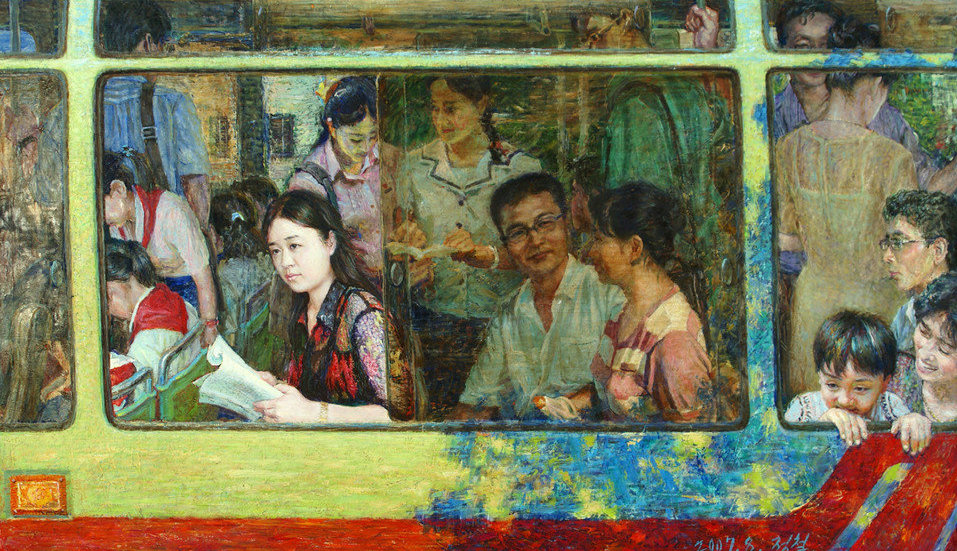Communism is the economic and political belief that all property is owned by the community. In reality, this mutates into the notion that everything is therefore owned by the state. Its opposite ideology is known as Capitalism, the system in which factors such as trade and industry are controlled by private owners for the goal of profit maximisation. Because all goods in the communist framework are theoretically not supposed to be restricted from certain members of the community, art, as a result, can be thought of as a good consumed by the public in a public setting – not as a private commodity consumed by the privileged select few.
One way to think of art in communist countries is that it belongs to the masses. In North Korea, a country with one of the most totalitarian communist regimes in the world today, the bus stops in its capital city of Pyongyang display beautiful artworks of landscapes or cityscapes instead of adverts or graffiti. National Geographic reports that buses in North Korea are the most common means of public transport, as tickets cost “5 won each, less than 0.1 US cents…making journeys virtually free”. People therefore are able to view these works of art on their daily commutes, at no additional cost to each commuter. Another example would be the underground rail system in Moscow. Unveiled in 1935, the architecture is opulent and extravagant and was meant to mimic the interiors of wealthy homes – bringing the palace to the people. Walls made of marble support ceilings that hold paintings depicting scenes from Russian history, while crystal chandeliers serve to illuminate all the beauty within each station. Since there are no commercial markets for art to be bought and sold, an optimistic view would be that art in this system is given a wider audience to be appreciated by, during something as trivial as a commute to and from work.
However, although communism may sound appealing in theory, history has shown that it never translates to success in practice. North Korea (also known as the ‘Democratic People’s Republic of Korea’) was founded in 1948 and has been ruled since its establishment by the communist Workers’ Party of Korea. The party’s current leader, Kim Jong-Un, inherited the position from his father, Kim Jong-Il, who himself inherited leadership from his father Kim Il-Sung – the first Supreme Leader of North Korea. Russia itself is no longer officially seen as a communist country, but at one point in its recent history it was known as the Soviet Union and was led by Lenin and then Stalin under the communist Bolshevik regime; the party then changed its name successively until it became the Communist Party of the Soviet Union in 1952. Both countries proclaim or proclaimed themselves to be communist, and yet they share many disturbing parallels with fascism in that both involve power centred around a key political figure. Propaganda in communist countries involves the idea of conforming to the state and therefore surrendering yourselves to the state. As the state is represented by one powerful political figure, such as Kim Jong-Un in North Korea or Stalin in Russia, it is therefore the case that in order to support your country, you must unquestioningly support that person in power. Disobedience or disloyalty against that political leader is seen as akin to treason, the ultimate betrayal of your country.
Seen in this more negative view, art can be interpreted as yet another way for the ruling communist party to push their propaganda onto the people. The unveiling of the Moscow train station under the Soviet Union was meant to show that communism was bringing to the country a level of advancement not seen in the inferior, capitalist neighbouring countries in Europe. Although Russia is now no longer communist, the ideology that communism is better than any other system is still present in North Korea. Everything from the military parades to the crowds of adoring viewers is choreographed to present a message of unity and happiness under the control of the Workers Party and Kim Jong-Un. Art, like the media, is yet another aspect that the party utilises to push their propaganda onto North Koreans as well as the world.
In an ideal world, perhaps it would be feasible to have art enjoyed freely and publicly by the masses, no matter your socio-economic background. There would be no restrictions or limitations, both on the kind of art produced as well as the people who can view it. Neither communism nor capitalism seem to be able to fulfil this promise however, so it seems that currently the choices we face consist of either free expression and restricted viewing, or restricted expression and free viewing.
Yasmin Bye
Image credit: Jong Chol / Huffingtonpost.co.uk

